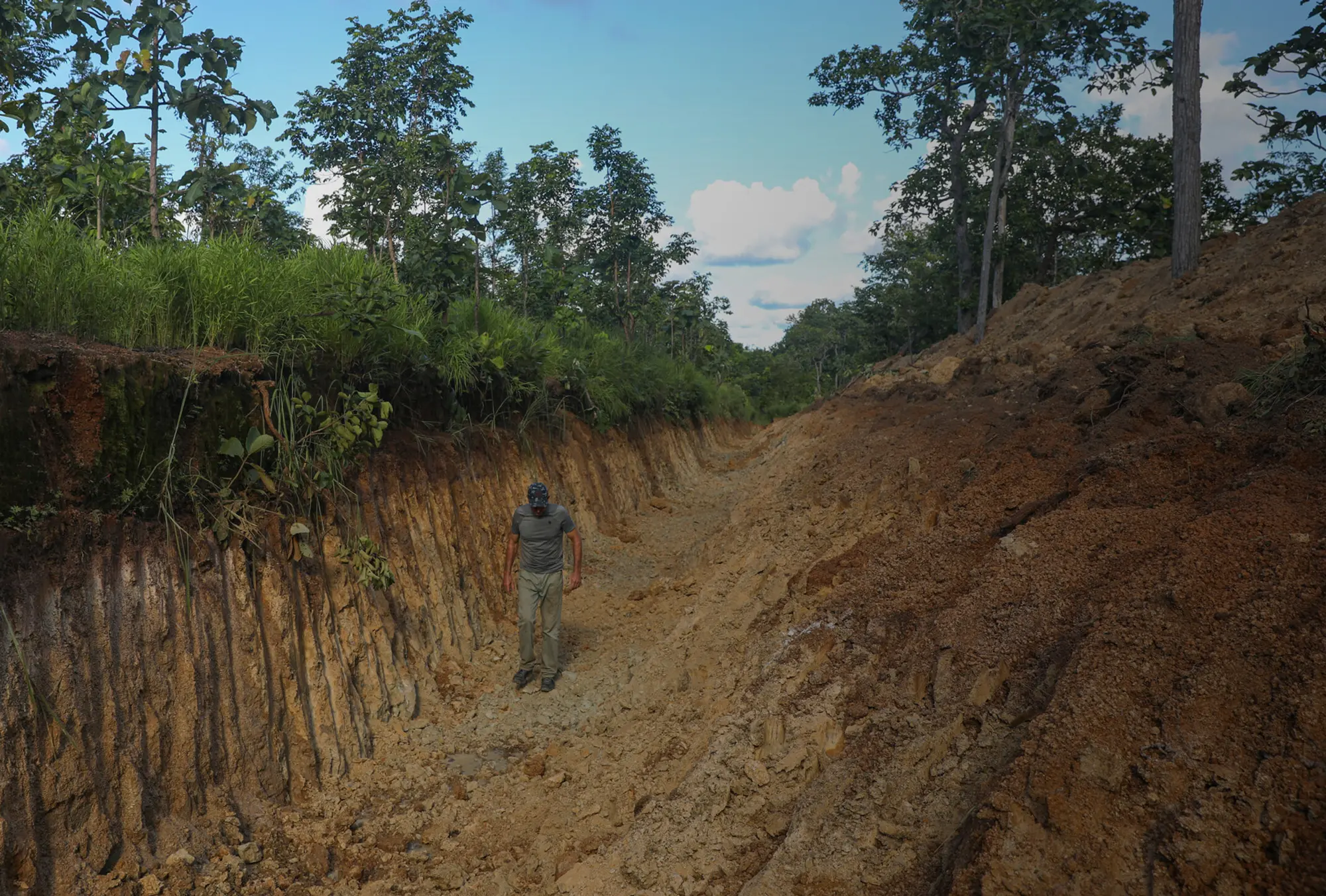
To prevent more local extinctions, an environmentally debatable trench is dug to fend off poachers and encircle wildlife.
Editor’s Note: This article is the second of two stories that delves into how Southeast Asia’s wildlife consumption affects human and forest health, with implications for biodiversity and future pandemics. The story is also available in Khmer.
Phnom Tnout, Cambodia—The treeline plunged into a chasmous trench carved around the heart of Cambodia’s Phnom Tnout Wildlife Sanctuary.
Dug with the intention of saving wildlife from poachers, the two-and-a-half-metre deep trench spans 17 kilometres around the core protected zone and is far from finished. With another 15 kilometres of digging and fencing to go, the trench draws a narrow line in the sand between environmental harm and benefit.
But environmentalists in charge of the dig say it’s a “d----- if you do, d----- if you don’t” conservation dilemma.
Millions of snares are estimated to exist within protected areas in Cambodia, Laos and Vietnam. While ranger patrols may mitigate the threat, studies question the extent of their effectiveness. In the last two decades, conservationists say Phnom Tnout has lost six species to poaching, which is why they refer to the trench as “a last-ditch effort” to stave off future local extinctions.
The trench exemplifies the severity of the snaring crisis in Southeast Asia which threatens the survival of several of the region’s endemic species.
“There is no perfect solution. But sometimes you just need to act before it is too late,” said Ben Davis, founder of BeTreed Adventures, an ecotourism lodge, who is spearheading the digging of the trench’s more than 30 kilometres. “A ditch is destructive, but it’s better to restrict wildlife and save them, than let them have their freedom to die.”
“Save them today”
Leaf litter cloaked the snare’s rope as vegetation on the forest floor camouflaged its noose from unsuspecting wildlife. Within a hundred-metre radius were six other snares.
But instead of removing the snares, community rangers left them as bait for poachers to return and be caught in the act.
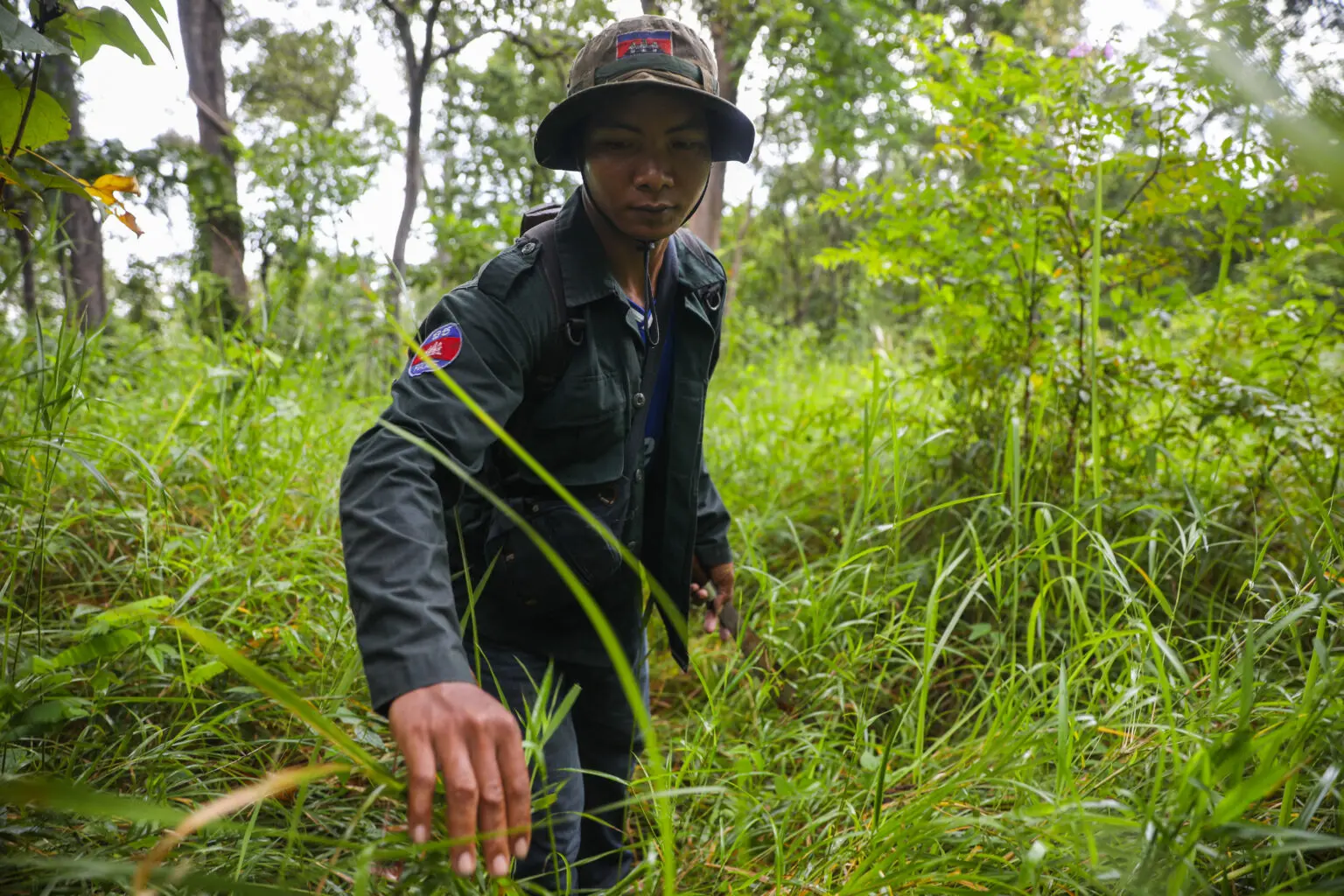
“I could find the snares just now, because I myself used to set them in the past,” said Chhoun Phirum, a ranger at Phnom Tnout, as he masked his tracks with long grass. But sometimes the bait doesn’t always work.
“Trouble is, it’s really hard to catch them. Yesterday, we tried to catch a poacher that was setting snares. He saw my team and ran away. That’s what normally happens,” said Davis, who estimated that only one in 20 poachers get caught. Before Phirum was a ranger, he was that one captured poacher.
“When I got caught, I also had to pay the fine, and decided to face the consequences,” Phirum said. “I realised my actions were unlawful and I decided to become a ranger to protect the forest instead.”
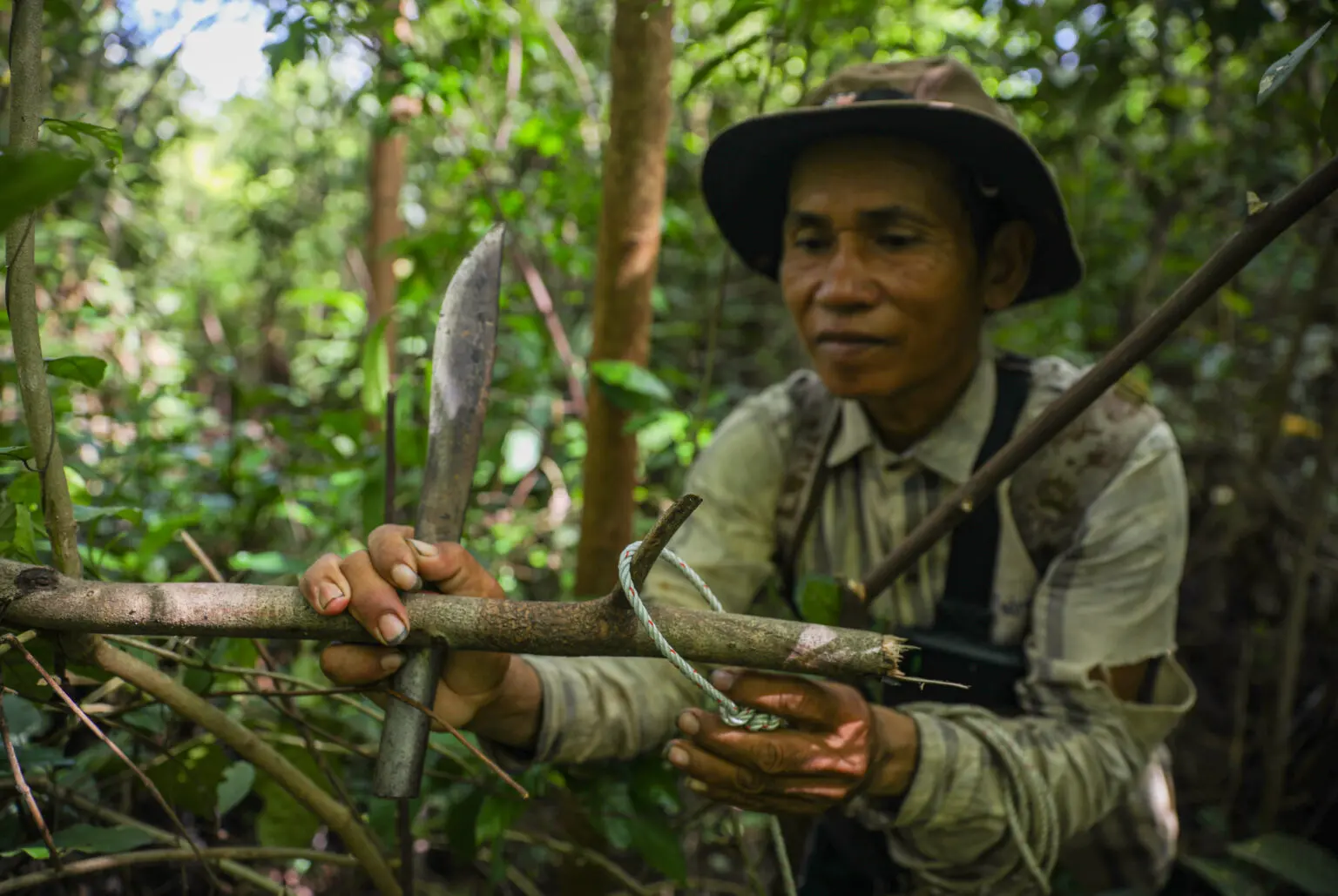
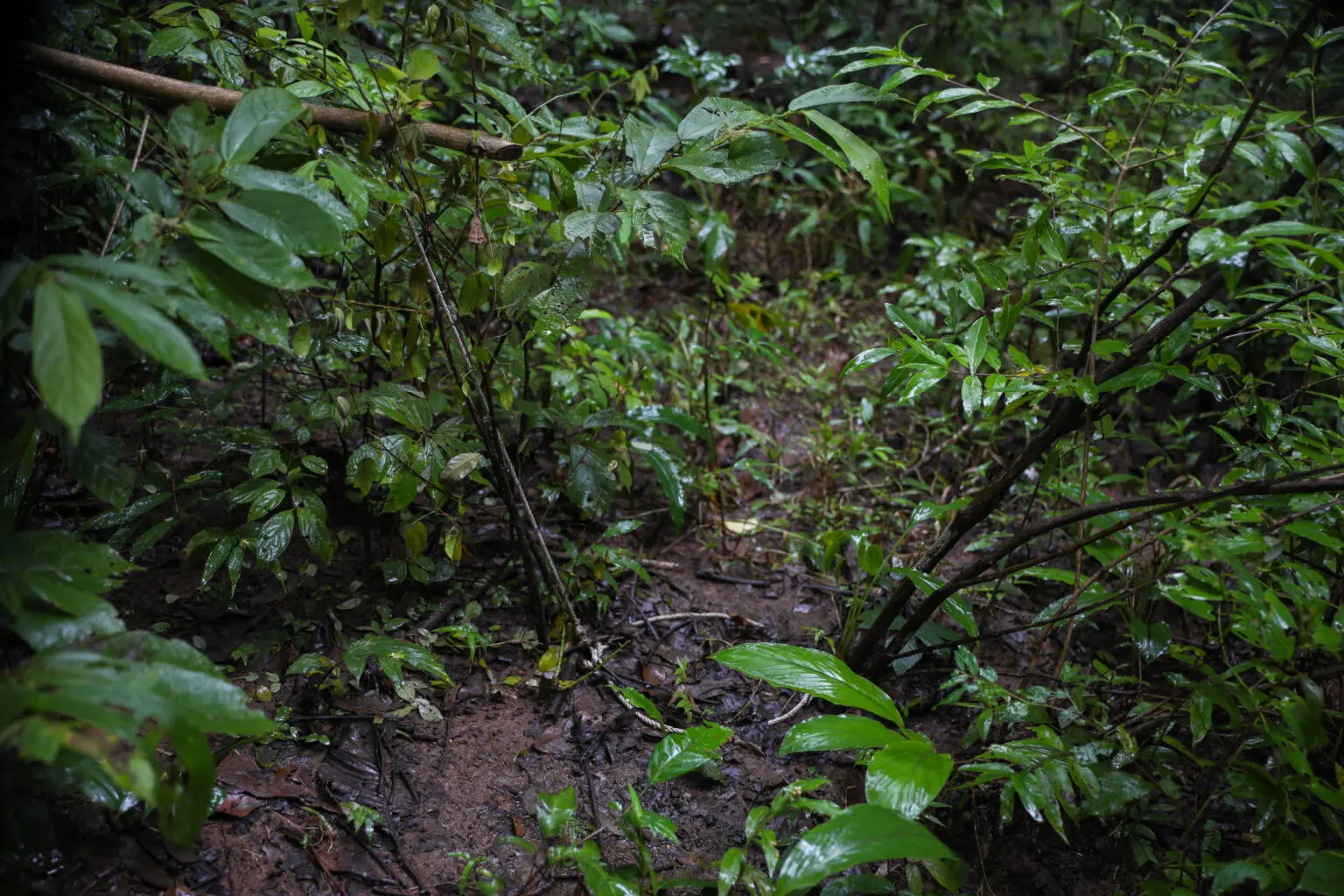
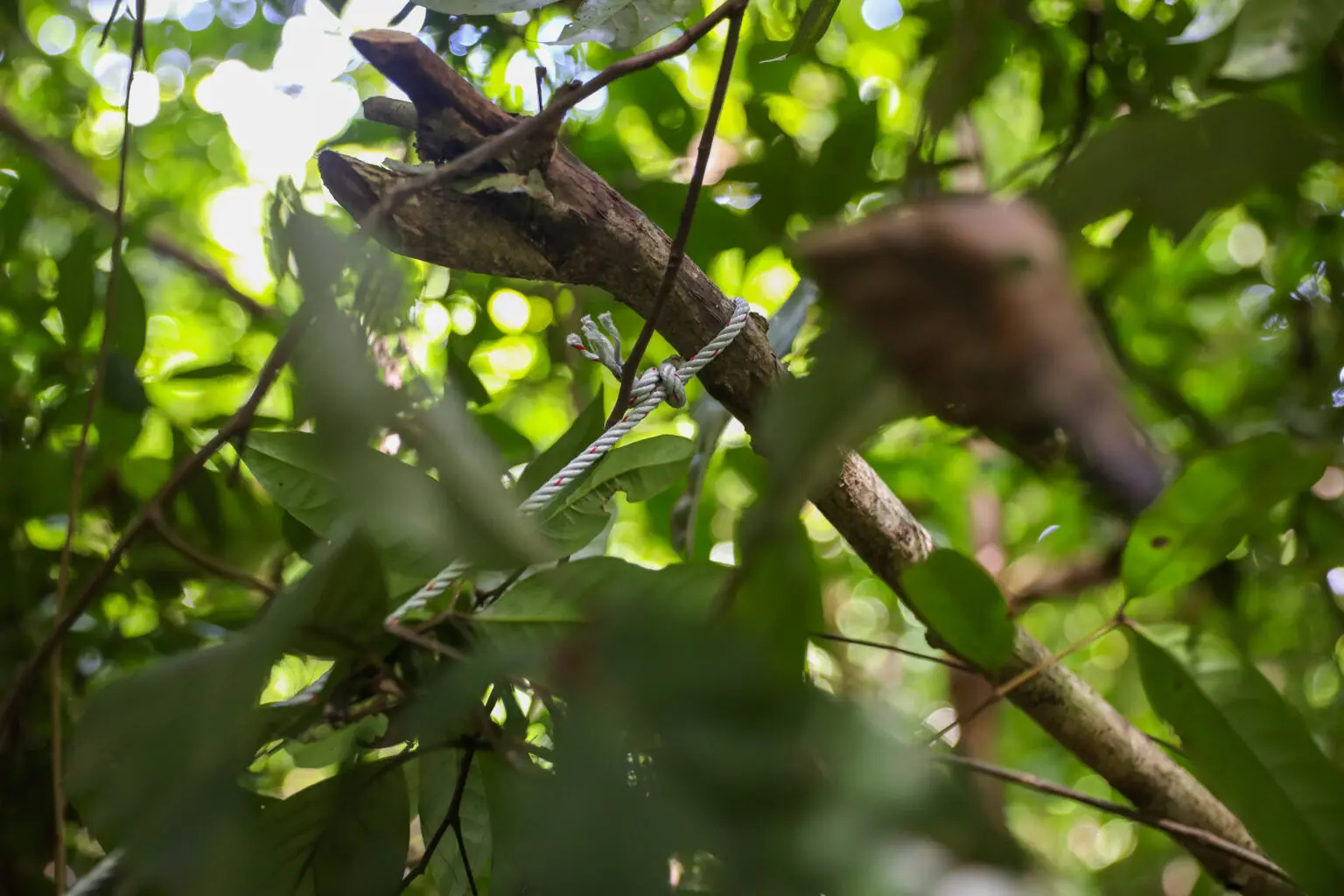
Snares are relatively simple traps with a noose for snagging the neck, torso or leg of an animal. Over the last two decades Davis has lived in Preah Vihear, he has watched as the contraptions have become cheaper, simpler and far more common.
Despite daily patrols, Davis said rangers are likely finding less than half of the snares set in Phnom Tnout, which is in the Kingdom’s northern Preah Vihear Province. In 2018, a snare detection study conducted in a protected area in eastern Cambodia found that patrols detected less than half of set snares.
“We just keep picking them up and they keep setting more,” Davis said. “It is very simple. Littles kids learn how to do it in five minutes. Everybody knows how to set snares.”
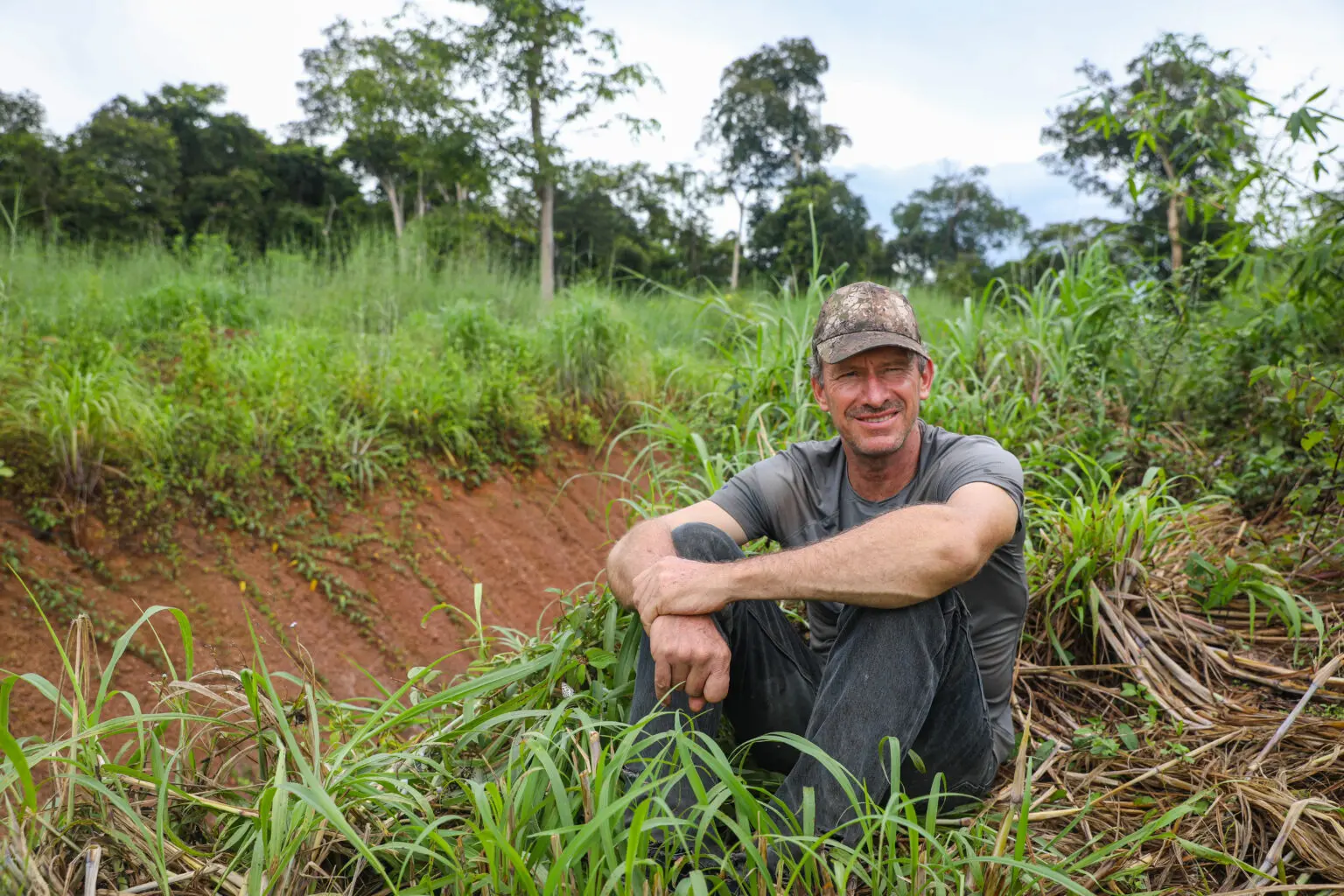
There are more than 12 million snares estimated to exist in protected areas within Cambodia, Laos and Vietnam, according to a 2020 World Wildlife Fund report, which broke down to around 110 snares per square kilometre of protected area.
“We are working blind because we don’t have a way to assess the effectiveness of snare removals,” said Minh Nguyen, a researcher at Colorado State University, who is studying snare-vulnerable species and trying to calculate the number of snares that would need to be removed for different animals to survive. “But even if we work intensively and extensively we could never get snares down to zero.”
In March, the Ministry of Environment in Cambodia launched a “zero-snare” campaign in an effort to change the hearts and minds of hunters and poachers. During the event launch, Neth Peaktra, spokesperson for the ministry, shared that more than 61,000 snares were removed from protected areas in 2021.
Regardless of the reasoning – whether for subsistence or for sale – Davis said the snaring pressure in Phnom Tnout is too great for endangered species, like banteng, to survive in the long term. Unless a new approach is made.
Farmland borders the boundaries of both Phnom Tnout and the ‘core area’ within the sanctuary, a zone which includes the park’s most pristine wildlife habitat. Farms that existed before the wildlife sanctuary was designated in 2017 were allowed to remain. But the lack of a buffer zone between farms and forest hurts conservation and increases human-wildlife conflict, said Davis, who believes saving animals from snares and gunshots requires fencing off.
In the last six months, excavators have dug 17 kilometres of the perimeter of the core area. The impact of the trench’s construction on the forest and wildlife movement is unquestionable. About a quarter of the trench so far has gone through dense forest, which Davis called “an unavoidable loss.” In the excavator’s wake, conservationists have been planting bamboo along the ditch in the hopes a natural barrier eventually regrows.
“This will become our first line of defence to stop illegal logging and poaching,” said Meas Nhem, deputy director of the Department of Environment in Preah Vihear, who confirmed this was the first time anything like the trench was being attempted. “The benefit is to prevent people from walking into the core area without any order. As well as the safety of the wild animals.”
While no official environmental impact assessment was conducted before digging began, Nhem said the trench was “technically assessed” and had ministry support. He declined to comment further.
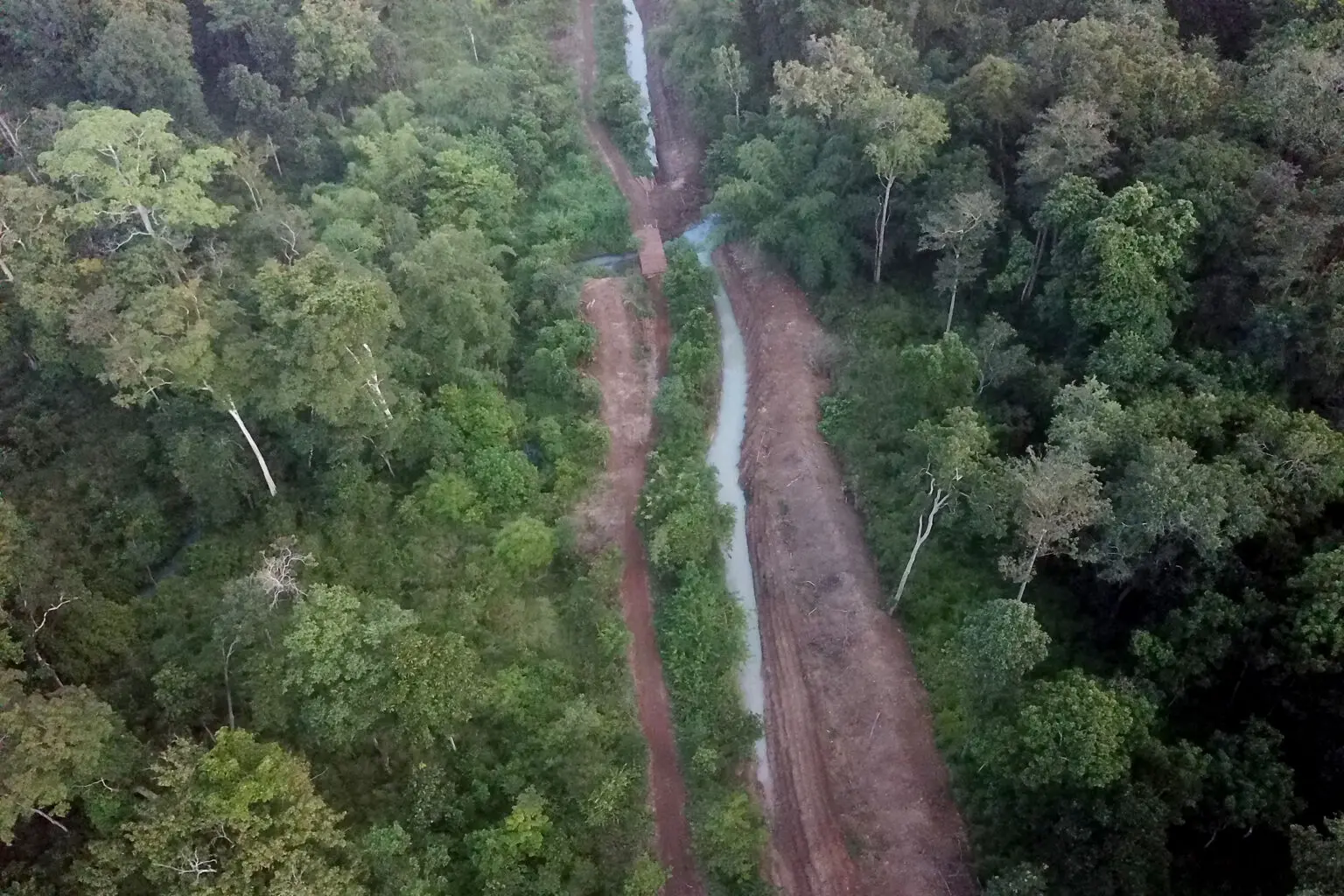
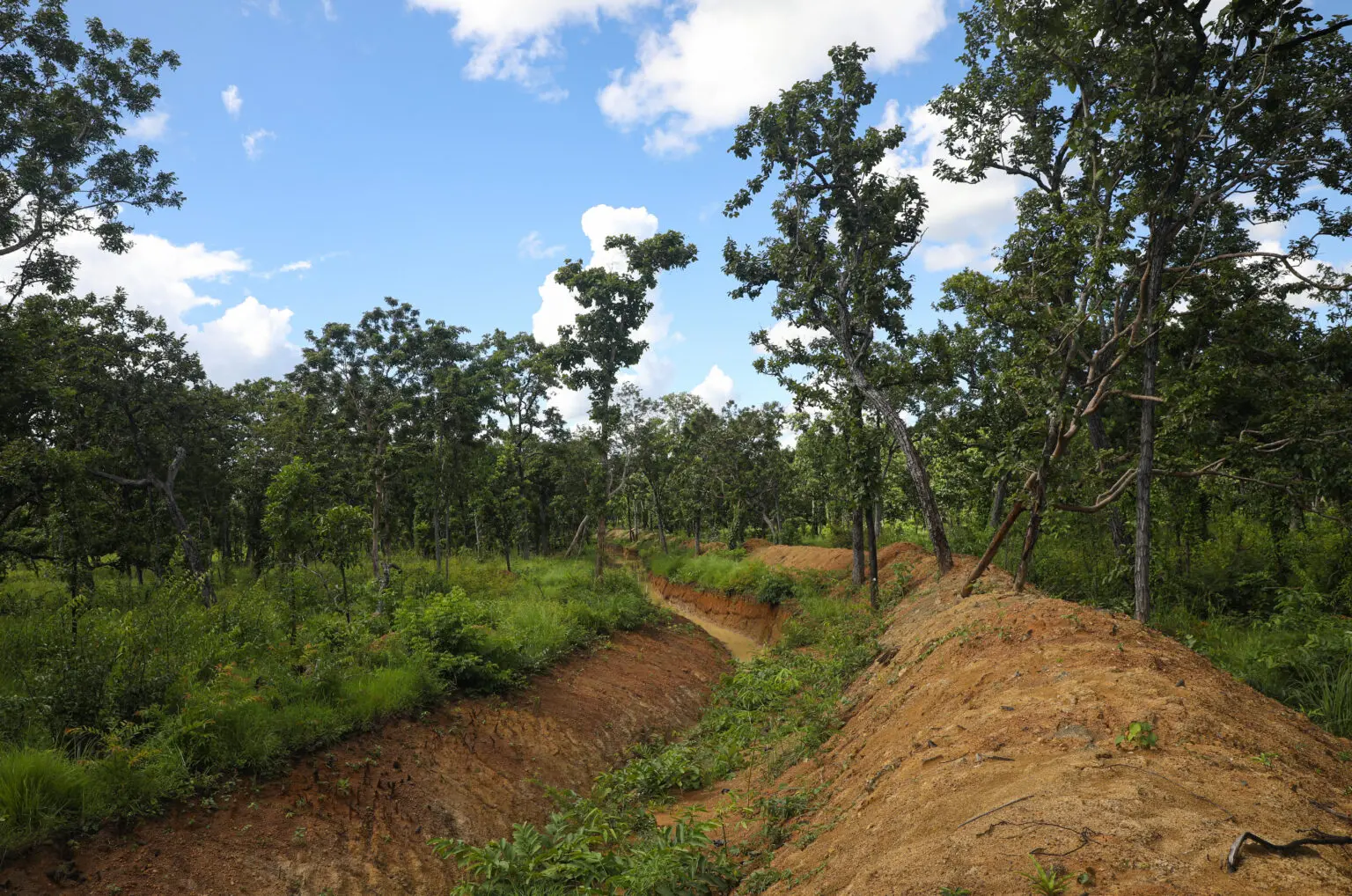
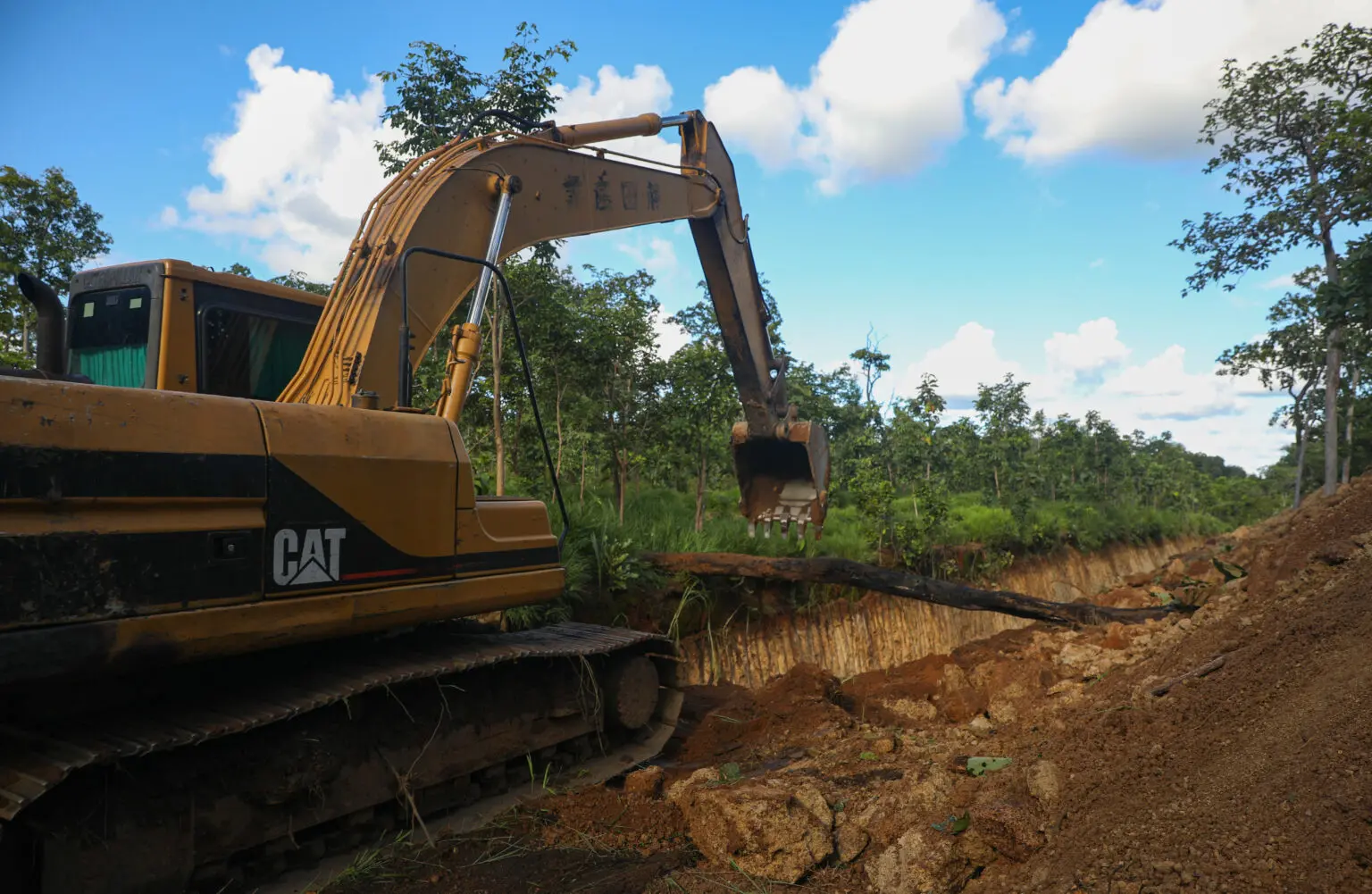
Restricting the sanctuary’s wildlife into 7,000 hectares also raises concerns over the movement and migration of certain species.
“Wildlife corridors to where?” Davis questioned, explaining that the core area was surrounded by farms and unpatrolled, likely heavily-snared, sections of forest. “At the way we’re going, even the way we’re protecting the forest, I cannot see in the future there’s going to be too much wildlife outside this ditch. We just cannot protect it all.”
The loss of wildlife in Southeast Asia’s forests is leading to what conservationist’s dub “empty” or “silent” forest syndrome, a situation where a habitat is left intact but songs and sounds of once-present species are no more. The long-term effects of multiple missing species in an ecosystem is still in the process of being understood.
A study on the impacts of hunting in Southeast Asia’s tropical forests found that compounding factors, including new technology, improved market access, escalating demand for wildlife meat, and exotic pets, means that “hunting cannot be considered sustainable anywhere in the region.”
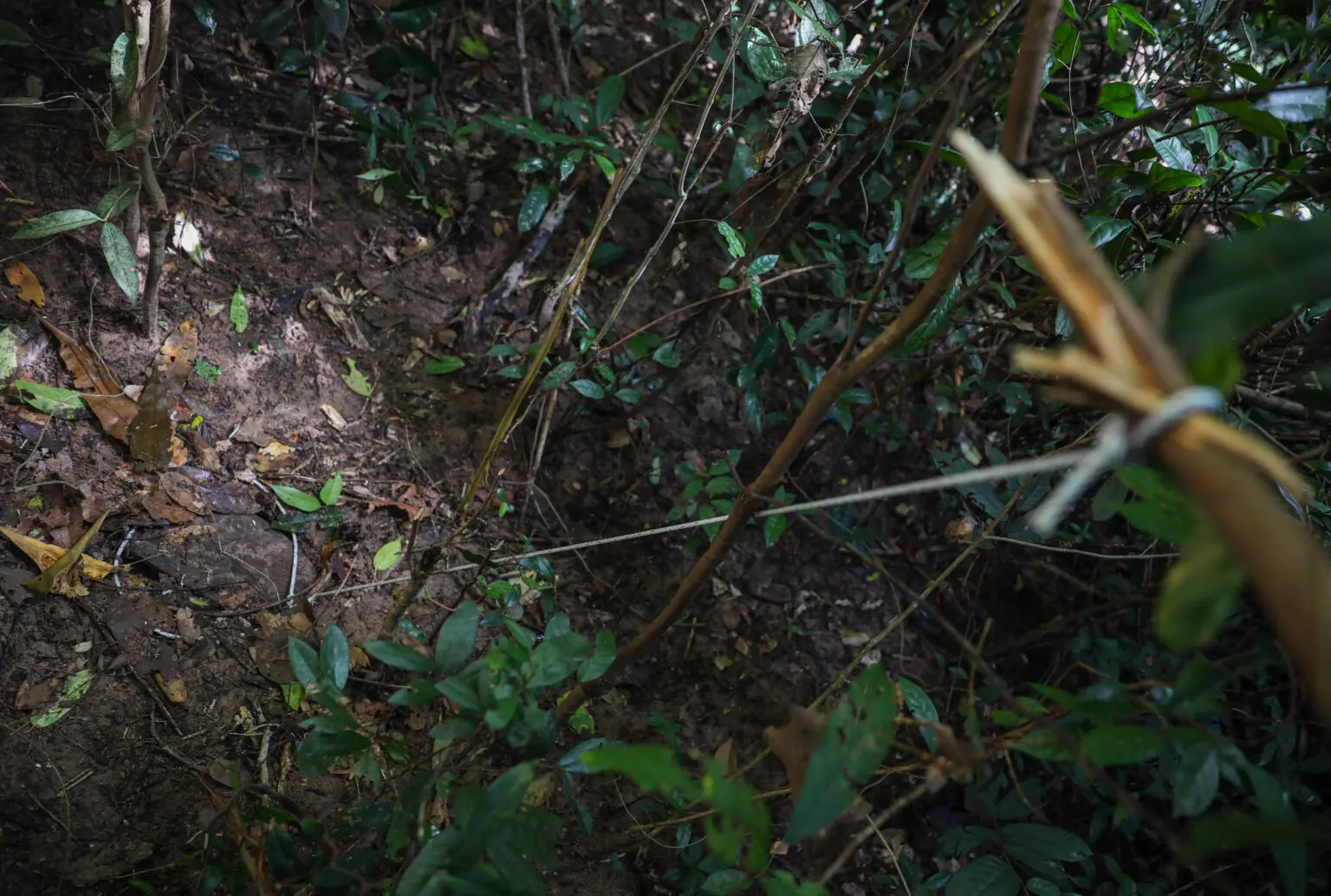
The emptying of forests for human consumption raises dual implications for forest and human health. Especially as the region is only beginning to economically recover from COVID-19, which is believed to have originated from a wildlife market.
As snares plague the region’s protected landscapes, drastic measures may become more commonplace.
“We can spend all day thinking about how different plans may be bad for animals in the long term. But we need to save them today, not tomorrow,” said Davis, who sighed when addressing that one day the core area may hold more wildlife than it could support.
“Well then, we can translocate them to another park where they’ve all been killed. But having too much wildlife? That’s a utopian dream.”
Additional reporting by Sophanna Lay.
- View this story on The Mekong Eye
- View this story on Kiripost
- View this story on VOD Khmer
- View this story on Focus Cambodia









